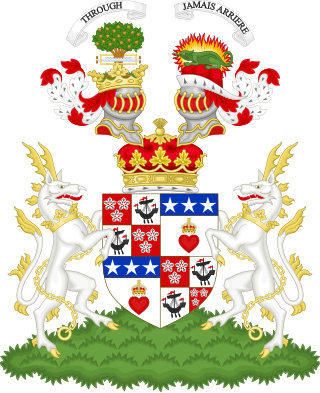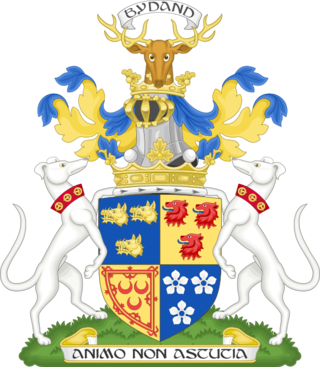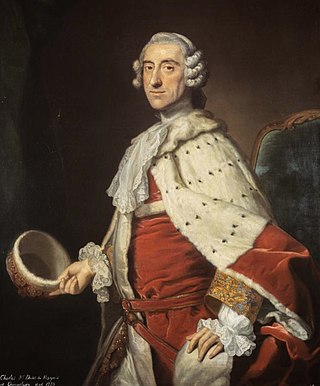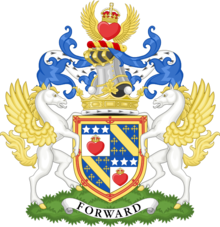Douglas, occasionally spelt Douglass, is a Scottish surname. It is thought to derive from the Scottish Gaelic dubh glas, meaning "black stream". There are numerous places in Scotland from which the surname is derived. The surname has developed into the given name Douglas. Douglas is a habitational name, which could be derived from any of the many places so-named. While there are numerous places with this name in Scotland, it is thought, in most cases, to refer to Douglas, South Lanarkshire, the location of Douglas Castle, the chief stronghold of the Lords of Douglas. The Scottish Gaelic form of the given name is Dùbhghlas ; the Irish-language forms are Dúghlas and Dubhghlas, which are pronounced. According to George Fraser Black, in southern Argyllshire the surname is an Anglicised form of the surnames MacLucas, MacLugash.

Earl of Wemyss is a title in the Peerage of Scotland created in 1633. The Scottish Wemyss family had possessed the lands of Wemyss in Fife since the 12th century. Since 1823 the earldom has been held with the Earldom of March, created in 1697. The holder of the title is sometimes known as the Earl of Wemyss and March, but the titles are distinct.

Duke of Argyll is a title created in the peerage of Scotland in 1701 and in the peerage of the United Kingdom in 1892. The earls, marquesses, and dukes of Argyll were for several centuries among the most powerful noble families in Scotland. As such, they played a major role in Scottish history throughout the 16th, 17th, and 18th centuries. The Duke of Argyll also holds the hereditary titles of chief of Clan Campbell and Master of the Household of Scotland.

Duke of Hamilton is a title in the Peerage of Scotland, created in April 1643. It is the senior dukedom in that peerage, and as such its holder is the premier peer of Scotland, as well as being head of both the House of Hamilton and the House of Douglas. The title, the town of Hamilton in Lanarkshire, and many places around the world are named after members of the Hamilton family. The ducal family's surname, originally "Hamilton", is now "Douglas-Hamilton". Since 1711, the dukedom has been held together with the Dukedom of Brandon in the Peerage of Great Britain, and the dukes since that time have been styled Duke of Hamilton and Brandon, along with several other subsidiary titles.

Duke of Buccleuch, formerly also spelt Duke of Buccleugh, is a title in the Peerage of Scotland created twice on 20 April 1663, first for James Scott, 1st Duke of Monmouth, and second suo jure for his wife Anne Scott, 4th Countess of Buccleuch. Monmouth, the eldest illegitimate son of King Charles II, was attainted after rebelling against his uncle King James II and VII, but his wife's title was unaffected and passed on to their descendants, who have successively borne the surnames Scott, Montagu-Scott, Montagu Douglas Scott and Scott again. In 1810, the 3rd Duke of Buccleuch inherited the Dukedom of Queensberry, also in the Peerage of Scotland, thus separating that title from the Marquessate of Queensberry.

The title Duke of Queensberry was created in the Peerage of Scotland on 3 February 1684 along with the subsidiary title Marquess of Dumfriesshire for the 1st Marquess of Queensberry. The Dukedom was held along with the Marquessate of Queensberry until the death of the 4th Duke in 1810, when the Marquessate was inherited by Sir Charles Douglas of Kelhead, 5th Baronet, while the Dukedom was inherited by the 3rd Duke of Buccleuch. Since then the title of Duke of Queensberry has been held by the Dukes of Buccleuch.

Marquess of Huntly is a title in the Peerage of Scotland that was created on 17 April 1599 for George Gordon, 6th Earl of Huntly. It is the oldest existing marquessate in Scotland, and the second-oldest in the British Isles; only the English marquessate of Winchester is older. The Marquess holds the following subsidiary titles: Lord Gordon of Strathaven and Glenlivet and Earl of Aboyne, and Baron Meldrum, of Morven in the County of Aberdeen.
The Peerage of the United Kingdom is one of the five Peerages in the United Kingdom. It comprises most peerages created in the United Kingdom of Great Britain and Ireland after the Acts of Union in 1801, when it replaced the Peerage of Great Britain. New peers continued to be created in the Peerage of Ireland until 1898

Viscount Cobham is a title in the Peerage of Great Britain that was created in 1718. Owing to its special remainder, the title has passed through several families. Since 1889, it has been held by members of the Lyttelton family.

The titles of Earl of Hertford and Marquess of Hertford have been created several times in the peerages of England and Great Britain.

Earl of Cardigan is a title in the Peerage of England, currently held by the Marquesses of Ailesbury, and used as a courtesy title by the heir apparent to that Marquessate, currently David Brudenell-Bruce, Earl of Cardigan, son of the 8th Marquess. The Brudenell family descends from Sir Robert Brudenell, Chief Justice of the Common Pleas from 1520 to 1530. His great-grandson, Sir Thomas Brudenell, was created a Baronet in the Baronetage of England, styled "of Deene in the County of Northampton", on 29 June 1611. On 26 February 1628, he was raised to the Peerage of England as Baron Brudenell, of Stanton Wyvill in the County of Leicester, and on 20 April 1661 he was further honoured when he was made Earl of Cardigan, also in the Peerage of England. On his death, the titles passed to his son, Robert, the 2nd Earl, and on the 2nd Earl's death to his grandson, George, the 3rd Earl, the 2nd Earl's only son, Francis, Lord Brudenell, having predeceased his father.
Earl of March is a title that has been created several times, respectively, in the Peerage of Scotland and the Peerage of England. The title derives from the "marches" or borderlands between England and either Wales or Scotland, and it was held by several great feudal families which owned lands in those districts. Later, however, the title came to be granted as an honorary dignity, and ceased to carry any associated power in the marches.
Earl of Ruglen was a title in the Peerage of Scotland. Along with the subsidiary titles Viscount of Riccartoun and Lord Hillhouse, it was created on the 14th of April, 1697, for Lord John Douglas-Hamilton, fourth son of William Douglas-Hamilton, Duke of Hamilton, 1st Earl of Selkirk, and his wife Anne Hamilton, 3rd Duchess of Hamilton. The 1st Earl of Ruglen succeeded as 3rd Earl of Selkirk on the death of his elder brother in 1739. The Earl's only son William, Lord Daer, died in 1742, so on the death of the Earl of Selkirk and Ruglen in 1744, the Earldom of Selkirk passed to his great-nephew, while the Earldom of Ruglen passed to his daughter, Anne, who had married William Douglas, 2nd Earl of March. On her death in 1748, the Earldom of Ruglen passed to her only child William, 3rd Earl of March. He succeeded his first cousin once removed Charles Douglas as 5th Marquess and 4th Duke of Queensberry in 1778.

Charles Douglas, 3rd Duke of Queensberry, 2nd Duke of Dover, was a Scottish nobleman, extensive landowner, Privy Counsellor and Vice Admiral of Scotland.

Archibald William Douglas, 8th Marquess of Queensberry PC, styled Viscount Drumlanrig between 1837 and 1856, was a British Conservative Party politician. He notably served as Comptroller of the Household between 1853 and 1856.

Francis Archibald Douglas, Viscount Drumlanrig, also 1st Baron Kelhead in his own right, was a British nobleman and Liberal politician.

Clan Douglas is an ancient clan or noble house from the Scottish Lowlands.

Charles Douglas, 6th Marquess of Queensberry,, known as Sir Charles Douglas, 5th Baronet between 1783 and 1810, was a Scottish peer and member of Clan Douglas.

Francis Archibald Kelhead Douglas, 11th Marquess of Queensberry, styled The Honourable Francis Douglas until 1900 and Viscount Drumlanrig between 1900 and 1920 was a Scottish soldier, stockbroker and author.
James Douglas, 2nd Earl of Queensberry was a Scottish noble, politician and Covenanter.
















